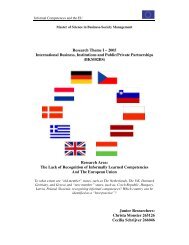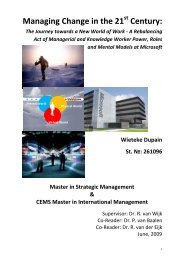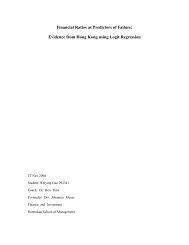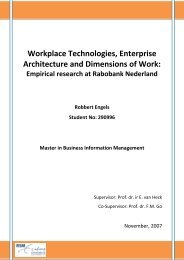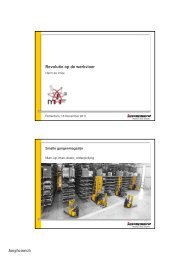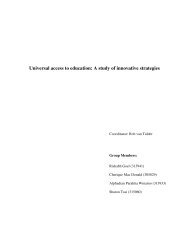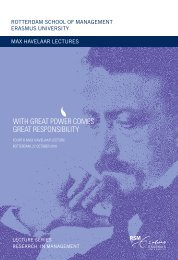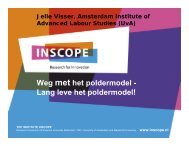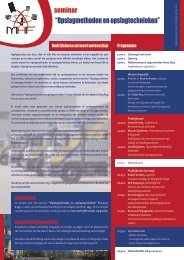Marketing Communication Strategies for Seaports - ERIM
Marketing Communication Strategies for Seaports - ERIM
Marketing Communication Strategies for Seaports - ERIM
Create successful ePaper yourself
Turn your PDF publications into a flip-book with our unique Google optimized e-Paper software.
<strong>Marketing</strong> <strong>Communication</strong> <strong>Strategies</strong> <strong>for</strong> <strong>Seaports</strong><br />
Jessica J.A. Siep 318556<br />
Introduction to Maritime Economics and Logistics<br />
Center <strong>for</strong> Maritime Economics and Logistics (MEL), Erasmus University Rotterdam<br />
December, 2010<br />
Introduction<br />
<strong>Seaports</strong> nowadays operate in a highly competitive market. The time of monopolies is gone<br />
as the hinterland is accessible <strong>for</strong> competitors (Pantouvakis, 2010). Differentiation is<br />
necessary to gain competitiveness. To communicate this differentiation marketing strategies<br />
are important.<br />
The selection of this marketing strategy is essential. It can improve financial results, or<br />
worsen it. It can also attract and satisfy customers, or it can have a negative effect. When a<br />
strategy is chosen, it has to be constantly adjusted in order to respond to the changing needs<br />
of the market.<br />
It is odd that marketing strategies <strong>for</strong> ports are not researched to a large extent. Cahoon<br />
(2007) and Pantouvakis (2010) researched the topic, but most of the academics left the<br />
subject alone. However, marketing strategies can add a lot of value.<br />
In this paper existing knowledge from the academic field of marketing in business will be<br />
interpreted <strong>for</strong> seaports. At the end, marketing communication strategies <strong>for</strong> seaports will<br />
be <strong>for</strong>mulated and analyzed.<br />
First, an overview of the development of ports as service businesses will be given. The<br />
establishment of inter-port competition answers the question why we need marketing<br />
strategies in this sector.<br />
Secondly, marketing communication will be explained and the main problem of intangibility.<br />
This will be applied to seaport marketing by looking at four major components. As this is a<br />
large field of study, we refocus on one dimension; the image in marketing communication.<br />
The Port of Amsterdam and the Port of Rotterdam will be researched on the ‘image’ strategy<br />
they are following. A web impact report will tell us more about the impact of the port. And<br />
1
the tools the ports use to communicate with the industry and the community provide us<br />
with valuable in<strong>for</strong>mation about how ports profile themselves. After analysis of the data,<br />
strategies can be <strong>for</strong>mulated.<br />
The development of ports as service businesses<br />
Ports have developed over the years and have changed in terms of organization, but have<br />
remained the area in which there is a transfer of cargo between ships and land (Branch,<br />
1986). Specifically, ports are the gateway to international trade, where the port area can be<br />
seen as an interface between sea and land (Haralambides, 2002). A port can thus be defined<br />
as a node that connects water- with land transport. The historical function of a port was<br />
solely limited to the natural area <strong>for</strong> transshipment from modes of transport an enjoyed<br />
monopoly power. Today, ports are engaged in inter-port competition and the function of<br />
ports now extends to factors including the management and coordination of materials and<br />
in<strong>for</strong>mation.<br />
Ports have been subject to changes in the market environment and the actions of relevant<br />
players including but not limited to: the government, shippers, carriers and third party<br />
logistics.<br />
Ports have traditionally been isolated from competitive <strong>for</strong>ces and enjoying monopoly<br />
power. The existence of trade barriers and the lack of adequate land transport<br />
infrastructure, allowed ports to serve their own captive hinterland (Haralambides, 2002).<br />
Increasing globalization and economic integration of areas, however, has led to a<br />
standardization of cargo reducing the barriers of transportation between countries to<br />
negligible levels. The standardization of containerized cargo has significantly reduced costs<br />
as modes of land transportation have now become uni<strong>for</strong>m. Containers have become<br />
‘footloose’ and are not tied to specific ports, resulting in traders having greater control and<br />
choice <strong>for</strong> respective ports. This development has ceased port hinterlands to be captive and<br />
these have now extended across national frontiers (Haralambides, 2002).<br />
This has reduced the monopoly power of ports and led to the development of ports now<br />
competing <strong>for</strong> trade. Ports are <strong>for</strong>ced to differentiate and compete on factors, fostering<br />
inter-port competition.<br />
In order to differentiate and compete an adequate marketing strategy has to be build. The<br />
services that ports offer have to be promoted to the industry to gain customers. Not only<br />
customers are important, but the society and other stakeholders also play a role.<br />
2
<strong>Marketing</strong> communication <strong>for</strong> service businesses<br />
<strong>Seaports</strong> can be defined as service-based businesses. The products they offer in a port are<br />
reliability, quality service, high sailing frequency, competitive rates, in<strong>for</strong>mation technology<br />
and professional management (Branch, Maritime Economics: Management and <strong>Marketing</strong>,<br />
3rd ed., 1998). This is different from tangible products like the ones container manufactures<br />
produce. You buy the product and you will get a tangible container. On the other hand,<br />
when you buy the product of a Seaport’s Port Authority you will not get a tangible product,<br />
but the service of using the ports facilities. This in turn is a difficulty <strong>for</strong> marketing the<br />
product.<br />
A number of characteristics of a service are constantly cited in the literature; intangibility,<br />
inseparability of production and consumption, heterogeneity and perishability.<br />
The most obvious is intangibility as services are no objects; they cannot be smelled or<br />
touched.<br />
The inseparability of production and consumption <strong>for</strong>ces the buyer into intimate contact<br />
with the production process as the customer has to be present during the production<br />
process (<strong>for</strong> example a haircut or a taxi ride)(Carmen, 1980).<br />
Heterogeneity has to do with the high variability in the per<strong>for</strong>mance of services. The quality<br />
varies from producer to producer, and from customer to costumer, and from day to day<br />
(Zeithaml, 1985).<br />
Perishablity means that services cannot be saved. Because they cannot be saved, businesses<br />
find it difficult to coordinate supply and demand (Thomas, 1978).<br />
The problem of intangibility<br />
The largest problem of a service <strong>for</strong> a marketing strategy is the intangibility. In marketing<br />
communication tangible objects will have a greater impact than intangible products. This can<br />
be explained by the idea that products that you can touch and hold have far less uncertainty.<br />
It is certain that you will receive the product as it is displayed. Furthermore, the tangible<br />
products can be easily compared and reviewed. This way, tangible products are clear and<br />
risk is minimized.<br />
Conversely, intangible products raise the perception of increased risk (Cahoon, 2007).<br />
Uncertainty is higher because of the intangibility and heterogeneity. Services cannot be<br />
compared the same way as tangible products as the quality can vary constantly. There<strong>for</strong>e,<br />
ef<strong>for</strong>ts have to be made to tangibilise the intangible services to reduce these perceptions of<br />
increased risk and uncertainty. This can be done by marketing.<br />
3
Seaport <strong>Marketing</strong><br />
Seaport marketing can be divided into three major components (Cahoon, 2007):<br />
<strong>Marketing</strong> communications<br />
1) Community liaison<br />
2) Trade and business development<br />
3) Customer Relationship Management (CRM)<br />
To give a complete overview of the three components a short description will be given.<br />
The role of community liaison can be described as a marketing tool to establish a mutual<br />
understanding and cooperation between the seaport and the community it operates in. This<br />
can be done by organizing discussion groups with the different stakeholders.<br />
Trade and business development is about generating more trade and grow as a business.<br />
Thus marketing is used here as to generate more output. Special offers and projects are<br />
used.<br />
Customer Relationship Management (CRM) manages the relationship between the customer<br />
and the company. The system identifies potential clients and track and trace the<br />
relationship. The aim is to find, attract and win new customers.<br />
The above mentioned components of seaport marketing deal with respectively the<br />
community, the trade and the customers. These are all very focused on one part of the<br />
market seaport operate in. On the other hand, market communications has a wider view and<br />
captures the whole market.<br />
In this paper marketing communications (MC) <strong>for</strong> seaport authorities will be examined.<br />
These are messages in all sorts of media send to the market. These messages are focused on<br />
the product itself and not on the company itself.<br />
To put MC in a framework we can look at a commonly used framework in marketing: “the<br />
four P’s”. This consists of Place, Product, Price and Promotion. MC can be placed under<br />
promotion as it ‘promotes’ the product in the market. This has a rather wide focus on<br />
marketing. There exist all sorts of messages. We will even further specify these messages in<br />
order to narrow our focus on the subject; marketing communication strategies <strong>for</strong> seaports.<br />
<strong>Marketing</strong> communication<br />
The messages send in marketing communication have different goals. We will discuss four<br />
different goals (Cahoon, 2007). Later on, one specific goal will be highlighted and further<br />
research will be presented.<br />
The first goal is ‘attracting new customers and in<strong>for</strong>ming current customers’. In the<br />
beginning, the existence of the seaport has to be communicated. Shipping has to be<br />
promoted as a way of transportation. Furthermore, most of the seaports have specialized<br />
4
themselves. To raise awareness of opportunities and benefits <strong>for</strong> this diversification,<br />
seaports have to advertise.<br />
Traditional <strong>for</strong>ms <strong>for</strong> advertisement are trade magazines, newspaper and television<br />
advertisements. These <strong>for</strong>ms are brought to the public. Another way of advertisement is to<br />
attract the (potential) customers to your advertisement. A very important medium<br />
nowadays is the internet. The website is a marketing tool <strong>for</strong> in<strong>for</strong>ming current and potential<br />
customers and the community about services and facilities provided by seaports (Cahoon,<br />
2007). Downloadable in<strong>for</strong>mation such as brochures, media and annual reports make the<br />
website a collection place of all sorts of advertisement and in<strong>for</strong>mation.<br />
The second goal is ‘in<strong>for</strong>ming and reminding the local community’. Next to attracting new<br />
customers by advertisement, they also fulfill a role of providing in<strong>for</strong>mation about the<br />
benefits to the local community. Tools are economic impact studies, sponsorships <strong>for</strong><br />
community projects, open days, seaport tours and local school projects.<br />
‘In<strong>for</strong>mation sharing with the seaport sector and maritime industry’ is the third goal.<br />
<strong>Seaports</strong> also increase the knowledge within the seaport sector and maritime industry. By<br />
organizing conferences and participate in committees, seaports raise interest and build<br />
knowledge.<br />
The last goal is ‘the seaport servicescape and image’. Booms and Bitner defined a<br />
servicescape as "the environment in which the service is assembled and in which the seller<br />
and customer interact, combined with tangible commodities that facilitate per<strong>for</strong>mance or<br />
communication of the service"(Booms, 1981). In other words; the surroundings influence<br />
both customers and employees. This is important because it can help reach goals of the<br />
internal organization and external marketing. It (de)motivates the employees and can attract<br />
new customers. The effect is stronger when dealt with inexperienced employees or<br />
customers and when in<strong>for</strong>mation is scarce. The feeling created by the servicescape is<br />
projected on the organization.<br />
There are three dimensions how employees and customers perceive the<br />
surroundings(Bitner, 1992):<br />
1. Ambient conditions<br />
2. Spatial layout and functionality<br />
3. Signs, symbols and artifacts<br />
We will focus on the last dimension; sings, symbols and artifacts, as marketing plays a major<br />
role. This dimension is important in <strong>for</strong>ming first impressions, communicating new service<br />
concepts, repositioning a service and differentiating from competitors. Especially the<br />
differentiating aspect has a high value because the servicescape can segment, position, and<br />
differentiate a company from its competitors.<br />
5
Interconnected with the servicescape is the image the seaport obtained. This is how<br />
customers and stakeholders perceive the overall image. Perceptions are important here.<br />
Perception is the process of attaining awareness or understanding of sensory in<strong>for</strong>mation<br />
(ox<strong>for</strong>d dictionary).<br />
Three generally perceptions of seaport are (Cahoon, 2007); (i) being customer-focused, (ii)<br />
contributing to the community; or (iii) being a well-managed efficient organization.<br />
<strong>Seaports</strong> that have a customer-focused image were perceived as focusing on customers’<br />
businesses, having a customer orientation and serving customer needs. The seaports with a<br />
community oriented image created an understanding of the contribution of the seaport to<br />
the community, as a major driver of economic-activity but also environmentally responsible.<br />
The professional image of a well-managed efficient organization comes from facilities a<br />
seaport has. Such as pilotage services, emergency operations and freezer facilities.<br />
So far, we looked at different levels in seaport marketing to give a structured overview of the<br />
field (Figure 1). In this paper we will focus on marketing communications. These are<br />
messages in all sorts of media send to the market. Predominantly, we will look at the<br />
seaport’s image, as it can help reach goals of the internal organization and external<br />
marketing. This paper will research how an image can reach those goals.<br />
First the methodology is explained and research presented. After this strategies will be<br />
<strong>for</strong>mulated <strong>for</strong> maximizing the effect of the image.<br />
seaport<br />
marketing<br />
Figure 1: overview seaport marketing<br />
marketing<br />
communications<br />
community<br />
liasion<br />
trade & business<br />
development<br />
CRM<br />
atracting &<br />
in<strong>for</strong>ming<br />
customers<br />
in<strong>for</strong>ming &<br />
reminding local<br />
community<br />
in<strong>for</strong>mation<br />
sharing with<br />
sector & industry<br />
servicescape &<br />
image<br />
6
Methodology<br />
To conduct a research on the images on ports and the effect on the organization and<br />
external marketing we have to study perceptions. To per<strong>for</strong>m a research on perception we<br />
look at the awareness and understanding of the seaport as these are key concepts in<br />
perceptions.<br />
Awareness will be tested by counting how many times a seaport is mentioned. This gives an<br />
idea on the impact of the seaport in the world. If a seaport is often mentioned, the impact is<br />
great and as a result the awareness is high. <strong>Seaports</strong> operate on a global scale and internet is<br />
the central medium <strong>for</strong> trade and communication is this sector (Morazzani, 2009).<br />
There<strong>for</strong>e, the internet will be used to per<strong>for</strong>m an impact assessment.<br />
When someone <strong>for</strong>ms an image of a seaport, the understanding of it plays a major role.<br />
<strong>Seaports</strong> are able to use various tools to give an understanding of the organization. These<br />
tools will be examined <strong>for</strong> two existing ports.<br />
The Port of Amsterdam and the Port of Rotterdam will be used in our research. Both ports<br />
are located in the Netherlands, located only 65 kilometers from each other. Furthermore,<br />
they share the same hinterland. This will enable us to per<strong>for</strong>m a comparative study and look<br />
at the differences and effects on the organization and community. The two ports will be<br />
unfolded to get a clear view on the differences.<br />
In short, the following questions fill be answered.<br />
Where and in what context is a seaport mentioned?<br />
How does the seaport communicate with the community?<br />
What type of seaport are we dealing with, and what are the effects of these<br />
characteristics?<br />
An analysis of the results will make clear how a seaport’s image can reach goals of the<br />
internal organization and external marketing.<br />
Research<br />
Web Impact Report<br />
Internet will be used to per<strong>for</strong>m a Web Impact Assessment. This is the evaluation of the<br />
“web impact” of ideas, documents or names by counting how often they are mentioned<br />
online (Thelwall, 2009). The idea is that something having more impact will be mentioned<br />
online more. Comparing web impacts from different organizations can be a proxy <strong>for</strong> their<br />
offline impact. Also, it is interesting to find out in which country it is mentioned.<br />
Web results would be indicative of a minimum level of awareness rather than definitive.<br />
Nevertheless, in a comparative study, each one would suffer from the same limitations and<br />
7
so comparing the results between them should be in<strong>for</strong>mative about which was the best<br />
overall (benchmark per<strong>for</strong>mance) (Thelwall, 2009).<br />
Web impact assessment via web mentions<br />
First, the phrase is submitted in a search engine. We use LexiUrl in this case. The reported hit<br />
count is used as the impact evidence. This simple technique has a few drawbacks, but by<br />
using some refinements the evidence can be made more robust. A commercial search<br />
engine such as Google will return the number of matching web pages. However, it is better<br />
to count matching web sites (i.e. URLs) as some sites may repeat the idea. Furthermore, a<br />
company can have a widely impact on community, without being mentioned op the internet.<br />
As a result, web impact evidence should be interpreted as indicative rather than definitive.<br />
Nevertheless, web impact assessment is valuable in our research as the internet is an<br />
important medium <strong>for</strong> the shipping industry.<br />
Content Analysis<br />
To interpret and explain the significance of the statistics we use content analysis. This is<br />
important because there are a variety of reasons why a web page could be created. This<br />
make it difficult to explain what a count of online mentions really means. We solve this by<br />
finding out what types of web pages are common in the result to give a description of what<br />
the statistic represents.<br />
Qualitative in<strong>for</strong>mation about the web citations can be obtained by visiting a random sample<br />
(100) of web pages from the study and reading them. The end result is a set of categories<br />
and an estimate <strong>for</strong> the number of search results fitting in these categories.<br />
Our interest is the organization origins of the online citations, thus classifications will include<br />
categories <strong>for</strong> the main organizations represented. These are Non-profit organizations,<br />
government, industry related and unrelated companies, press or blogs and academic<br />
websites.<br />
Results<br />
A random sample of 100 web pages per seaport was examined following the methodology<br />
presented above. Figure 2 represents the percentage of web pages per category of<br />
organizations. It shows us that the Port of Amsterdam is mentioned more in non-profit<br />
organizations (NPO) such as the World Cacao foundation. NPO often us a domain name<br />
different from .com. Top level domains (TLD) often used are .org, or .edu. This can also be<br />
seen in figure 3. The Port of Amsterdam has 12,4 percentage more web pages in these TLDs<br />
than Port of Rotterdam.<br />
8
Non-profit<br />
Government<br />
Industry unrelated<br />
Industry related<br />
Press or blogs<br />
Academic<br />
Figure 2: percentage of web pages per category of organizations<br />
Furthermore, the Port of Amsterdam is mentioned less in industry related businesses than<br />
Port of Rotterdam. Port of Amsterdam can be found at the sites of hotels and<br />
advertisements companies, whereas Port of Rotterdam is mostly cited on logistic service<br />
providers’ websites.<br />
Domain "Port of Amsterdam" "Port of Rotterdam"<br />
com 41,9% 47,8%<br />
nl 5,2% 14,4%<br />
org 10,7% 4,1%<br />
be - 1,1%<br />
net 2,9% 3,2%<br />
co.uk 2,2% 1,1%<br />
edu 6,4% 0,6%<br />
eu 0,3% 0,5%<br />
de 0,7% 0,5%<br />
com.au 1,0% -<br />
gov - 0,5%<br />
org.uk 0,5% 0,4%<br />
Figure 3: top-level domains of pages <strong>for</strong> all the data sets<br />
In the top-level domains figure one can see that the Port of Amsterdam is cited;<br />
Less in the Netherlands<br />
More on .org TLDs<br />
More on .edu TLDs<br />
More in the UK<br />
0% 5% 10% 15% 20% 25% 30% 35% 40%<br />
Port of Amsterdam<br />
Port of Rotterdam<br />
9
The .org and .edu can be linked with the higher percentage of NPO. However, the difference<br />
in the percentage of citations in the UK and the Netherlands is significant.<br />
Lastly, the number of times each seaport is cited in a press or blog is very high. The sites are<br />
<strong>for</strong> example (local) news sites (CBS news, volkskrant).<br />
Seaport Events<br />
<strong>Seaports</strong> use various tools to create understanding of the organization in the community.<br />
Awards, special days, exhibitions and seminars are widely used. However, the intended<br />
image the seaports are trying to generate can be different. The three perceptions are<br />
(Cahoon, 2007); (i) being customer-focused, (ii) contributing to the community; or (iii) being<br />
a well-managed efficient organization.<br />
We will categorize the events and compare the two seaports along these categories.<br />
Categories Awards Special days exhibitions Seminars<br />
customer-focused Intermodal<br />
Europe 2010<br />
Contributing to Havenfotowedstrijd SAIL<br />
Haven<br />
the community<br />
Havenfestival<br />
IJmuiden<br />
rondvaart<br />
well-managed<br />
Museumhaven<br />
efficient<br />
organization<br />
Amsterdam<br />
Figure 4: Port of Amsterdam<br />
Categories Awards Special days exhibitions Seminars<br />
customer-focused Intermodal<br />
Europe 2010<br />
Contributing to<br />
Wereld Maritiem Museum<br />
the community<br />
havendagen<br />
Havenbeeld<br />
Haven Museum Havendebat<br />
well-managed<br />
efficient<br />
organization<br />
Figure 5: Port of Rotterdam<br />
Port Dues Award<br />
FutureLand<br />
In<strong>for</strong>matie centrum<br />
Notable from figure 4 and 5 is that the Port of Amsterdam is perceived as the most as<br />
contributing to the community. The Port of Rotterdam has more an image of a wellmanaged<br />
efficient organization.<br />
Next to the events organized by the seaports, the way new employees are attracted also is<br />
an important indicator <strong>for</strong> the marketing image.<br />
10
(Future) Employee activities<br />
The activities to attract new employees will be evaluated and categorized. The subjects <strong>for</strong><br />
the activities are categorized according to the education <strong>for</strong>m.<br />
Amsterdam Primary<br />
School<br />
JINC<br />
Education/project<br />
Gave Haven<br />
Project<br />
Figure 6: Port of Amsterdam<br />
Rotterdam Primary<br />
School<br />
Schooltv<br />
Education/project<br />
Maritiem<br />
museum<br />
Figure 7: Port of Rotterdam<br />
Secondary School Higher<br />
education<br />
Work@water Haven college<br />
JINC<br />
Future expedition<br />
Amsterdam<br />
De vaart erin!<br />
Hogeschool<br />
Amsterdam<br />
VU Amsterdam<br />
Job seekers<br />
Werkenindehaven.nl<br />
Secondary School Higher education Job<br />
seekers<br />
Spetterende<br />
opleidingen<br />
STC<br />
Watertalent<br />
Hogeschool<br />
Haven<br />
Cargodoor worden Rotterdam<br />
carrière<br />
Erasmus University<br />
Rotterdam<br />
Havenwerk<br />
From the figures 6 and 7 can be seen that the Port of Amsterdam is focused on primary<br />
school to higher education. On the other hand, the Port of Rotterdam is more focused on<br />
higher education and jobseekers.<br />
At this point we can compare the two ports on web impact, perceptions from events and<br />
activities to attract employees. However, we have to take in mind that these ports are not<br />
the same. We will give a short description of the characteristics of the two ports and<br />
evaluate the effects of these.<br />
Type of seaport<br />
Both ports operate under the landlord model. Under this model the Port Authority acts as<br />
regulatory body and as landlord, while port operations (especially cargo-handling) are<br />
carried out by private companies (World Bank, 2009).<br />
Main differences can be found in the type of cargo handling, connections, tourism and the<br />
mission statement (Port of Rotterdam, 2010) (Port of Amsterdam, 2010).<br />
11
Rotterdam handles 350 million tons of cargo more than Amsterdam. And the area<br />
Rotterdam has is consequently much bigger. The Port of Amsterdam is specialized in sand,<br />
coal and oil products. Furthermore, it is the largest cacao port in the world.<br />
The Port of Rotterdam’s main cargo is crude oil and petroleum products, and Rotterdam is<br />
the major grain and container harbor of Europe.<br />
Both ports can be seen as junctions <strong>for</strong> multi-modal transportation with connections with<br />
inland waterway (Rhine), rail and road networks. Amsterdam has a close connection to the<br />
airport Schiphol. However, the port has restrictions due to the three North Sea Locks.<br />
Rotterdam has no restrictions in time or size <strong>for</strong> the vessels.<br />
Despite of having a smaller port with less cargo handling, Amsterdam receives more cruise<br />
ships than Rotterdam (104 vs. 26). The city of Amsterdam is also far more touristic than<br />
Rotterdam.<br />
Lastly, the mission statements of the ports have some differences:<br />
Amsterdam:<br />
‘The Port of Amsterdam’s mission is to be a reliable port and to manage the economic<br />
activities and employment at the Amsterdam <strong>Seaports</strong> in a sustainable manner.'<br />
Rotterdam:<br />
'The Port of Rotterdam Authority develops in partnership the leading European Port of<br />
world stature'.<br />
The Port Authority is fully committed to keep developing the port and industrial complex of<br />
Rotterdam to be the most competitive, innovative and sustainable in the world. We create<br />
value <strong>for</strong> customers by developing chains, networks and clusters.<br />
The difference can be explained by looking at the three images (i) being customer-focused,<br />
(ii) contributing to the community; or (iii) being a well-managed efficient organization.<br />
Amsterdam’s mission is customer focused (reliable) and community-focused (manage<br />
economic activities and employment).<br />
Whereas Rotterdam is customer focused (create value <strong>for</strong> customers) and well-managed<br />
efficient focused (leading European Port).<br />
Analysis and insights<br />
The main findings are summarized in Figure 8. We can deduct two different strategies these<br />
harbors follow, despite they are both industrial, landlord model, ports.<br />
12
Port of Amsterdam Port of Rotterdam<br />
Web impact report<br />
NPO 24% 8%<br />
Industry related 8% 32%<br />
Press and blogs 34% 32%<br />
Domain .nl 5,2% 14,2%<br />
Sea port events<br />
Events contributing to the<br />
community<br />
Education primary school to higher<br />
education<br />
well-managed efficient<br />
organization<br />
higher education and<br />
jobseekers<br />
Type of seaports<br />
Cargo handling 70 million ton 420 million ton<br />
Specialization sand, coal, oil products and crude oil, petroleum products,<br />
cacao<br />
agri and container<br />
Restrictions Yes, locks No<br />
Cruise ships 204 per year 26 per year<br />
Mission statement customer focused and<br />
customer focused and well-<br />
community-focused<br />
managed efficient focused<br />
Figure 8: summary of results<br />
Strategy 1 - Amsterdam – specialized, society-focused<br />
The Port of Amsterdam is a relatively small port with restrictions (locks). There<strong>for</strong>e it has to<br />
focus more on the type of cargo. Because of this specialization the Port of Amsterdam does<br />
not have to attract general cargo as much as a port depending on general cargo.<br />
As a small, specialized company, it can be hard to create awareness, understanding<br />
employees from the community. The port is rather invisible <strong>for</strong> the town and jobseekers.<br />
There<strong>for</strong>e, Amsterdam has to create this awareness and understanding. This can be seen in<br />
the events the port organizes and the mission statement it published. Education is directed<br />
to children and young adolescents. This way, awareness and understanding is created at the<br />
basis of the population.<br />
The society focused strategy can also be seen in the web impact of the Port of Amsterdam.<br />
As a specialized port it does not have to attract general logistical companies. Only a small<br />
percentage of them work with this port. As a result, not a lot of industry related companies<br />
mention Amsterdam.<br />
Furthermore, as Amsterdam invests a lot in the community, a lot of NPO’s, press and blogs<br />
mention the port.<br />
You can describe the strategy the Port of Amsterdam is following as a specialized port, which<br />
is society focused, because of the lack of awareness, understanding and good skilled<br />
workers.<br />
13
Strategy 2 - Port of Rotterdam – General, professional image<br />
The Port of Rotterdam can be typified as a large general multi-modal seaport. No natural<br />
restrictions exist and a lot of companies are active in the area. As general cargo port,<br />
awareness has to be created <strong>for</strong> using shipping as a way of transportation. This can be seen<br />
in the percentage of industry-related websites where Rotterdam is mentioned. Furthermore,<br />
a lot of blogs and news sites refer to the port.<br />
As a rather big port, the community is more aware of the existence of the port and its<br />
economic benefits. Hence, Rotterdam does not focus that much on the society. They focus<br />
on a well-managed efficient organization image. By profiling themselves as a professional<br />
organization, talented and well-skilled employees are attracted, and innovative, and firstrate<br />
companies.<br />
In the education programs, Port of Rotterdam also focuses on higher education and job<br />
seekers, this in order to attract talented people with developed competencies.<br />
The mission statement reflects the strategy Rotterdam is following nicely. 'The Port of<br />
Rotterdam Authority develops in partnership the leading European port of world stature'.<br />
The approach: A general port, which is focused on a professional image, to attract first-rate<br />
companies and employees in order to be a leading port in the world.<br />
Conclusions<br />
The image strategy ports follow depends heavily on the natural factors, the city it belongs to<br />
and the type of port it is. Examining the way ports profile themselves to the community and<br />
the sector reflects the strategy followed.<br />
In this paper we have looked at the web impact, which tells us more about the awareness of<br />
the seaport. We also looked at the marketing communication tools ports use to give an<br />
understanding of the sector and organization.<br />
It is important to note that the image strategy followed has an important effect on the way<br />
the society and the industry sees the particular port. It is thus necessary to make a sound<br />
decision on the strategy chosen. In this paper we have seen two different strategies; society<br />
focused and professional image, chosen by respectively a specialized and general cargo port.<br />
Further research on other ports can identify other strategies. When a full set of strategies<br />
exists a theory can be build <strong>for</strong> which strategy to choose in different circumstances.<br />
14
Bibliography<br />
Bitner, M. J. (1992). Servicescapes: The Impact of Physical Surroundings on Customers and<br />
Employees. Journal of <strong>Marketing</strong> , 57-71.<br />
Booms, B. (1981). <strong>Marketing</strong> <strong>Strategies</strong> and Organization Structures <strong>for</strong> service firms.<br />
Washington State University, School of Business and Economics , 36.<br />
Branch, A. E. (1986). Elements of Port Operation and Management. Chapman 8 Hall, New<br />
York .<br />
Branch, A. E. (1998). Maritime Economics: Management and <strong>Marketing</strong>, 3rd ed.<br />
Cahoon, S. (2007). <strong>Marketing</strong> communications <strong>for</strong> seaports: a matter of survival and growth.<br />
Maritime Policy & Management , 151 - 168.<br />
Carmen, J. M. (1980). Growth <strong>Strategies</strong> of Service Firms. Strategic Management Journal , 7 -<br />
22.<br />
Haralambides, H. (2002). Competition, excess capacity, and the pricing of port infrastructure.<br />
International Journal of Maritime Economics , 323-347.<br />
Morazzani, J. Z. (2009). Relationships, In<strong>for</strong>mation Technology and the Shipping Industry –<br />
An Exploratory Investigation. IMP Group .<br />
Pantouvakis, A. M. (2010). <strong>Marketing</strong> <strong>Strategies</strong> in Port Industry: An Exploratory Study and a<br />
Research Agenda. American Journal of Economics and Business Administration , 64-72.<br />
Port of Amsterdam. (2010). www.portafamsterdam.com. Retrieved November 26, 2010<br />
Port of Rotterdam. (2010). www.portofrotterdam.com. Retrieved November 26, 2010<br />
Thelwall, M. (2009). Introduction to Webometrics; Quantitative Web Research <strong>for</strong> the Social<br />
Sciences. San Rafael: Morgan & Claypool.<br />
Thomas, D. R. (1978). Strategy is different in service business. Harvard business review , 158 -<br />
165.<br />
World Bank. (2009). Alternative port management structures and ownership models.<br />
Zeithaml, V. A. (1985). Problems and <strong>Strategies</strong> in Services <strong>Marketing</strong>. Journal of <strong>Marketing</strong> .<br />
15





